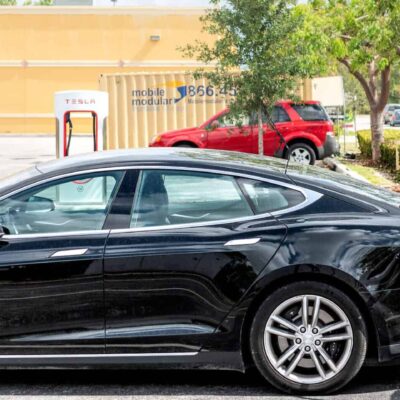The past 150 years have seen the automotive industry transform the idea of a vehicle from a luxury item to a daily essential. These early inventions shocked the public in their time, and the evolution of the automobile has been equally as enchanting as the market has grown from glorified buggies to self-driving trucks. The journey to today has been a tumultuous one, and it isn’t going to get any less interesting as we move towards a fully electric and automated future that is largely focused on one thing: the electric vehicles market.
To discuss the industry’s trajectory as we head into the next decade, WIT brought together a panel of experts with knowledge on aspects of all things automotive. These professionals have decades of experience working in vehicle design and manufacturing, and are active in the electric vehicles industry.
The Experts
WIT’s VP of Operations, Mike Connelly, was joined by Laine Mears, who has over 25 years of experience in automotive manufacturing; Andrea Strzelec, a leading expert in engine systems; and Marcus Gilmore, who has spent over a decade working on sustainable energy systems and has recently focused on green transportation.
We started the conversation among the panelists on the topic of meeting electrification goals- namely, the U.S. goal to have half of all new cars be zero-emission by the start of the next decade. Several other countries have created benchmarks for their success in EV implementation as well.
Despite our panelists shared interest and expertise in the automotive industry, these professionals don’t always hold the same opinions when it comes to the future of the electric vehicles market.
Core to the discussion were viewpoints on what it would take for the U.S. to meet its target. The following is a snapshot of the obstacles and opportunities our experts believe will shape this electrification revolution.
Batteries
What influence do outside industries have on the next generation of automotive manufacturing? According to our experts, there are many, specifically in battery manufacturing and design. In fact, battery materials, battery management systems, battery cell designs, and battery assemblies continuously evolve, and our experts feel much can be learned from other industries in terms of best practices.
Additionally, the concept of “wells to wheels” is important in evaluating electric vehicle battery manufacturing. Industry expert, Andrea Strzelec, specifically argues that the industry needs to look at the full cradle-to-grave lifecycle when discussing batteries and getting to zero emissions. This not only refers to the manufacturing of the battery itself but also what is needed to source the materials. Strzelec states, “We can make a lot of comparisons about what it takes to make an engine versus what it takes to make a battery or electric power system. When we look at battery manufacturing, there are a lot of emissions associated with not only electricity generation but the battery manufacturing. And that goes from the actual physical manufacturing of the battery once you have the materials and the sourcing of the raw materials for the batteries—things like lithium mining and cobalt mining as well.”
Supply Chain
Since the use of electric and hybrid vehicles is not yet widespread, there is currently a push to get consumers on board with these concepts whether it be through the resale market or new vehicle purchases. And with other countries, especially those in Europe, being more willing to pay premiums for environmental sustainability, we must ask: will the U.S. supply chain get further choked because of our slow adoption?
Industry expert Laine Mears doesn’t think so; he feels that the market will respond if the demand is there. With more manufacturers like Nissan and Ford making affordable models, price-sensitive consumers will be ready to participate in the shift, making the 2030 goal seem more feasible.
As for the supply of energy, Strzelec put it best when she said, “Lithium is going to be a big, big problem.” With lithium being used to create all battery types, the supply of this material will inevitably deplete. And since China is the largest supplier of lithium, this also brings up questions and concerns around global relations.
EV Adoption
One of the most important elements to evaluate when looking at the future of the electric vehicles market is that of consumer sentiment. With the US being slow to adopt these electric vehicle concepts, clean transportation advocate Marcus Gilmore categorizes potential early adopters into two separate groups: EV converts—those who believe in the concept of electric vehicles—and rebate essential customers—those who need incentives to crossover from transitional ICE vehicles.
Gilmore has firsthand knowledge of the impact of those incentives to potential buyers through his work at Center for Sustainable Energy – his team rolled out an incentive program in New Jersey two years ago. The incentives aimed to advance the electrification of the transportation sector, and they made what they thought were aggressive projections for EV deployment based on historical data. But after their incentive plan rolled out in May of 2020, they were shocked by the results. Gilmore told us, “All of the funds that were allocated for that fiscal year have been expanded. So, in less than a year, we distributed more than $30 million in incentives, and the same happened again this year.” This point drives home the impact that can be made through the use of more incentive programs to entice consumers to transition to a next-generation vehicle.
The Challenges
We have seen manufacturers begin to show concern over the increased costs associated with battery creation and vehicle design, which can potentially create a supply chain shortage. Because of this, many companies are facing the decision of creating more vehicles or supporting the growing resale market. As Gilmore said, “We are trying to push customers into new-generation vehicles because when you continue to encourage the growth of the markets, you create demand. In turn, that creates an incentive for OEMs to continue to ramp up production. So, because new ventures are always risky in any industry, the automotive industry is particularly challenged to really break in at scale. A lot of the established programs are taking a more cautious approach in announcing limited first production volumes.”
Mears feels that these issues are associated with the widespread adoption of electric vehicles. He explained, “1% of our cars are fully electric in the US today. I’ve seen predictions of ten times that, 20 times that.” Since the United States is such a price-sensitive market, he feels that it is becoming increasingly difficult to forecast the industry’s progression on account of growing demand and expanding incentives.
Environmental factors can also create barriers in the electric vehicle market. The pandemic has made remote and hybrid work a normal part of American culture, which brings up the question of whether range anxiety still played a factor among potential EV drivers.
Gilmore told us, “If you’re charging at home, you’re not really commuting as much as you were before, and you have a generous incentive along with tax credits that help achieve cost parity with ICE vehicles. That was something that we did not anticipate happening. So, we had a huge surge in demand. That was what we saw in 2020 and then in 2021. With some of the issues that have already been touched upon that’s contributed to supply chain shortage, a different set of issues were presented that we didn’t anticipate a couple of years ago, which is oversubscription or the delay in receiving vehicles from a number of OEMs.”
Now, with incentives ramping up, Gilmore anticipates that demand will begin surging beyond the supply. Since the pandemic has made remote work the norm, people’s schedules have changed. He feels that this has caused consumers to drive less and worry less about charging, making range anxiety less of a barrier.
With regard to range anxiety, however, Strzelec feels that it is still an issue. She said, “When we look at vehicle miles traveled and fuel use last year, the pandemic had almost no effect… You can look at the data published by Oak Ridge National Laboratory and see that vehicle miles traveled and fuel use were actually only initially hit by the pandemic and after that really picked back up.” Essentially, she thinks that remote work hasn’t helped decrease the stress surrounding battery power since people are still driving just as much as they did pre-pandemic. This means that range anxiety continues to play a role as consumers still need to charge their vehicles, but the US does not yet have widespread charging capabilities. Mears, though, feels that this issue will be mitigated by the coming changes in charging infrastructure.
What’s Next?
Stay tuned for more from this conversation with our top electric vehicles experts. In our next post, we’ll share their insights on EV infrastructure and the future of hybrid vehicles. Contact us to request access to the recorded panel discussion of Chapter One and follow us on LinkedIn and Twitter to stay up to date on our latest insights.
Get the full recording of Chapter 1 from our EV Panel Discussion to watch immediately by submitting your contact information.




